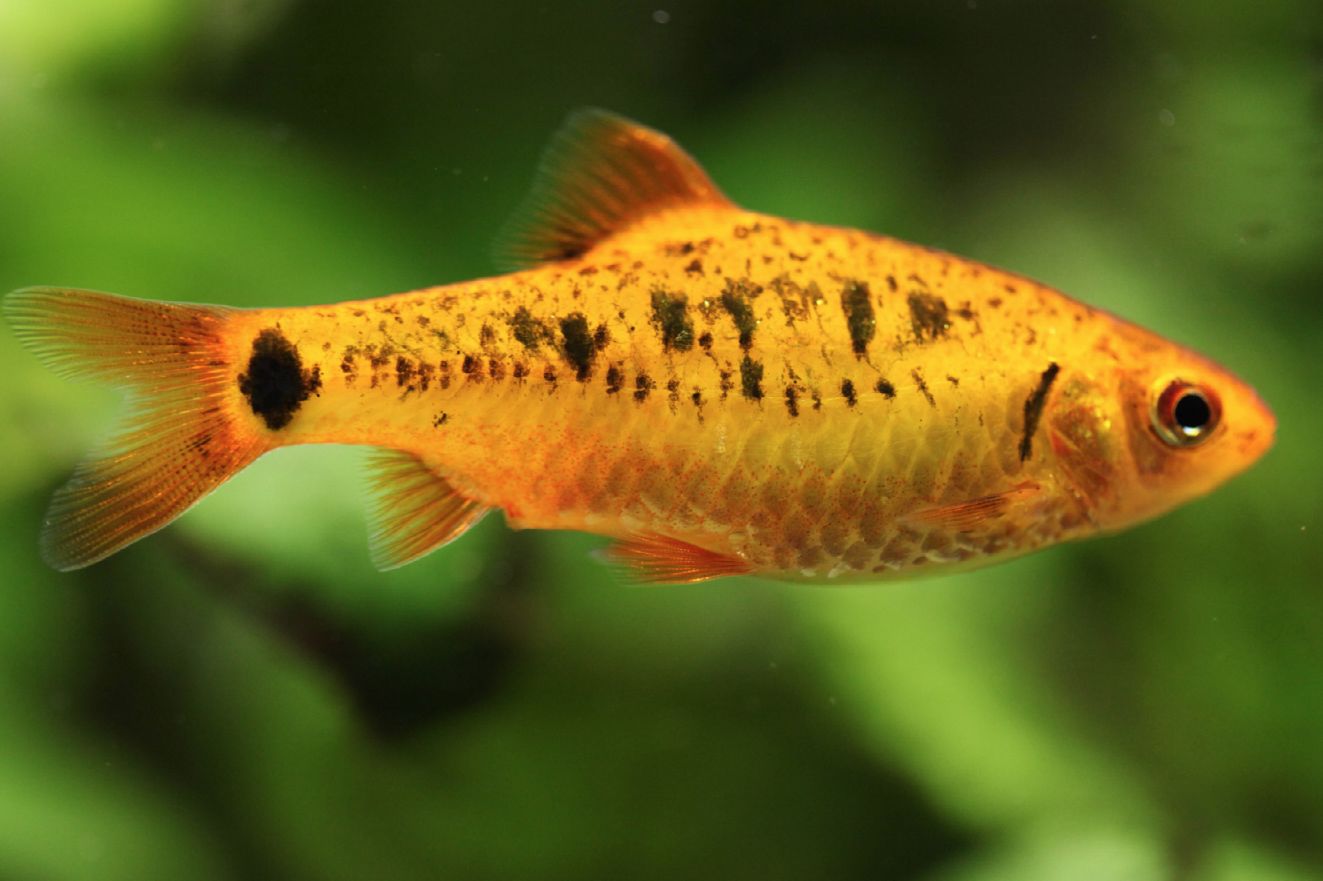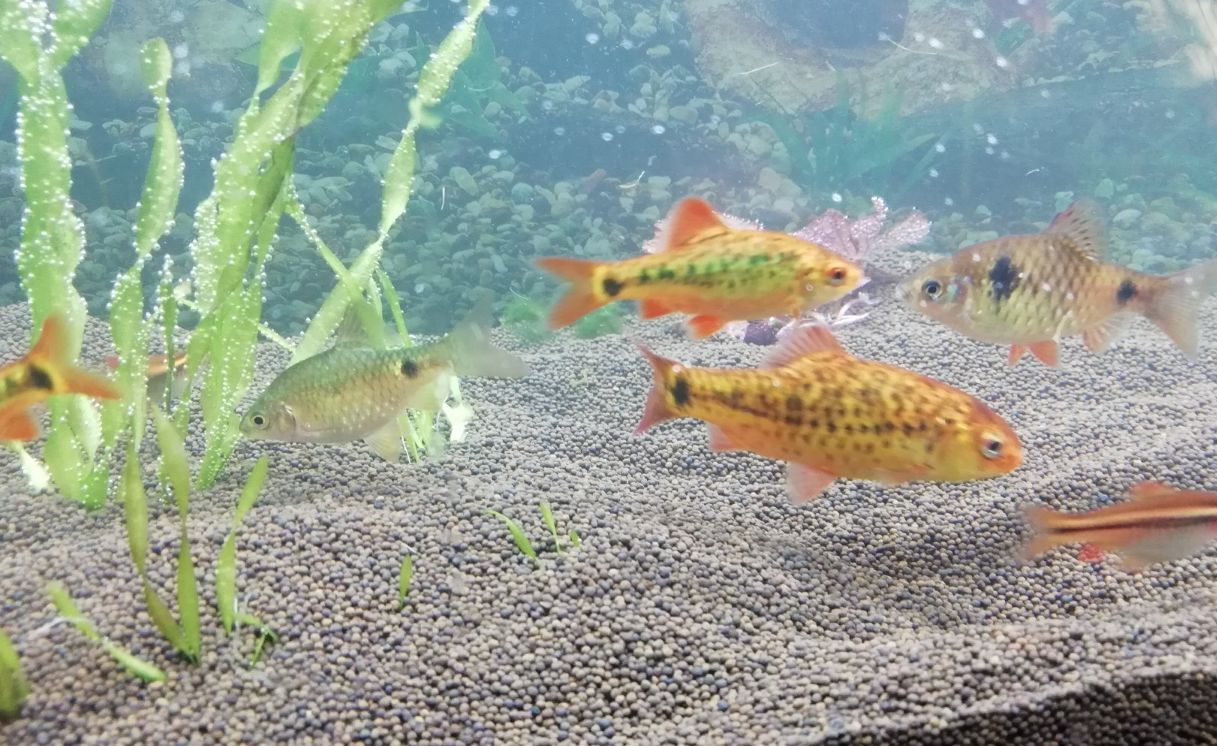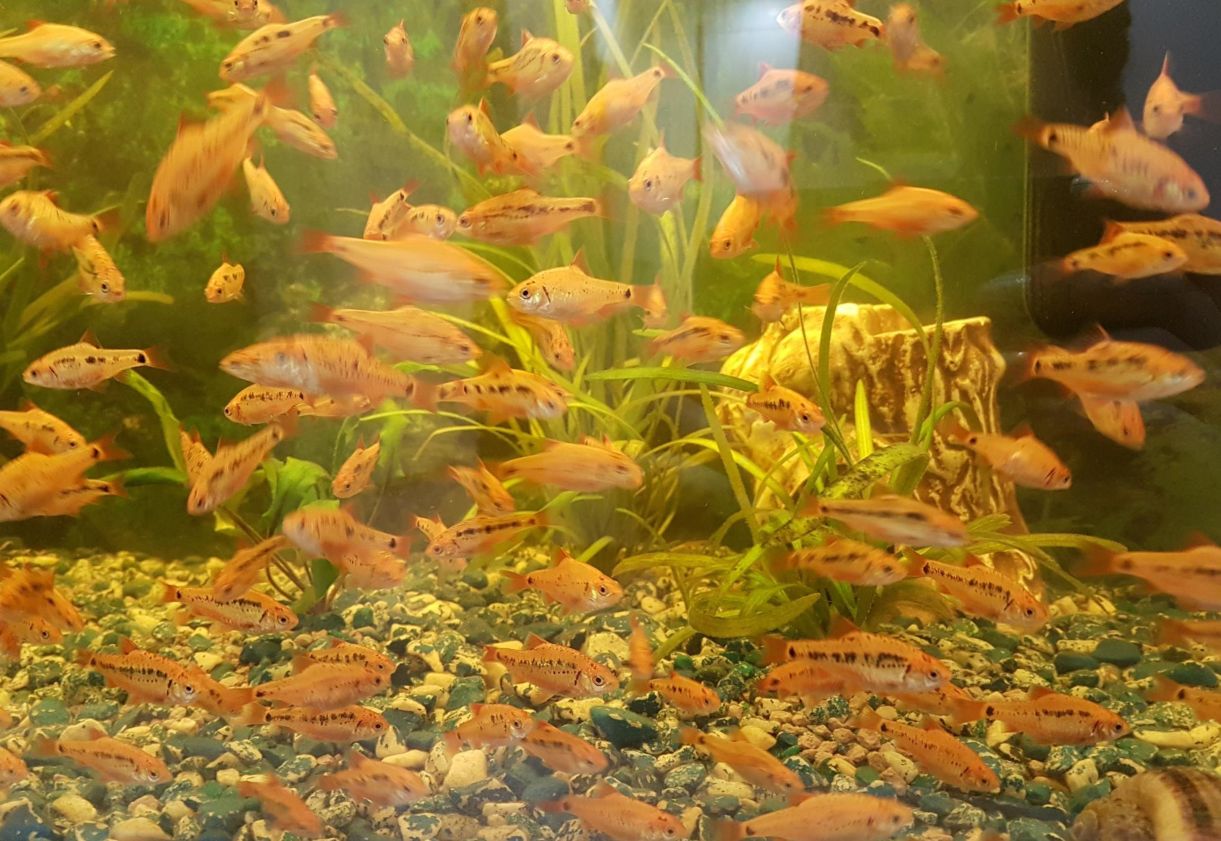The gold barb (Barbodes semifasciolatus) is a small freshwater fish belonging to the Cyprinidae family, known for its peaceful temperament and striking golden-yellow coloration. This makes it an appealing choice for community aquariums. In this article, you’ll discover how to properly care for gold barbs, what to feed them, suitable tank mates, and tips for breeding.

Contents
Habitat in the wild
The gold barb, also known as the Chinese barb, is a popular freshwater fish among aquarium hobbyists. It belongs to the Cyprinidae family, which is the largest family of freshwater fish and includes various species such as minnows, carps, and other barbs.
The scientific name Barbodes semifasciolatus var. Schuberti indicates that this variety was developed through long-term line breeding by American aquarist Thomas Schubert. The absence of wild populations supports the idea that this fish was bred artificially. One of its names, the Schuberti barb, honors its creator.
In the wild, the gold barb is found in China, Taiwan, Vietnam, and other Southeast Asian countries, contributing to its alternate name, the Chinese barb. Wild specimens lacked the bright coloration we see today, exhibiting gray-green scales. In contrast, the selectively bred gold barb shines brilliantly in aquariums, making it a favorite among aquarists.
Gold barbs inhabit lentic or slowly flowing waters, typically warming to 24 °C in the summer. They generally feed in the upper water layers and rarely dive deeper than 5 meters. Their natural habitats often experience seasonal temperature fluctuations, with winter temperatures dropping to 10-15 °C in some areas. Consequently, these fish can thrive in unheated tanks in captivity.
In milder climates, gold barbs can also be kept in garden ponds during the summer. Outdoor conditions enhance their coloration and growth. They feed on algae and insects that fall into the water, making the natural environment beneficial for their overall health.

Description
The gold barb has a classical fish body shape, being moderately flattened from the sides and elongated. Its back is slightly more curved than its abdomen. A pair of short barbels can be found on either side of its mouth; these sensory organs assist in locating food and navigating its environment. While present, the barbels are not as prominent as in some other barb species.
A distinctive feature of the gold barb’s coloring is a dark-green lateral stripe adorned with scattered black spots. These spots also appear on its dorsal and tail fins. The fins exhibit a striking red-orange hue, while the back coloration ranges from yellow-olive to red-cinnamonic. During spawning, the light-colored abdomen transforms into a vibrant orange-red. The sides of the body shimmer with a greenish tint, contrasting with the brassy-yellow underside. Notably, the tail fin displays a classic Y-shape, highlighted by a large dark spot at its base.
Gold barbs typically have a lifespan of around 5 to 8 years in captivity. However, individual lifespans can vary significantly depending on factors such as care quality, genetics, diet, and the overall health of the fish.
In terms of size, gold barbs are relatively small fish when fully grown. An adult gold barb may reach up to 7 centimeters (2.8 inches) in length, though they usually do not exceed 5 centimeters (2 inches). While some individuals may attain the upper size limit, others might remain slightly smaller, reflecting the variability within the species.
| Characteristic | Description |
|---|---|
| Scientific Name | Puntius semifasciolatus var. Schuberti |
| Common Names | Gold Barb, Golden Barb, Chinese Barb, Schuberti barb |
| Family | Cyprinidae |
| Origin | East Asia (China, Taiwan) |
| Size | 2-3 inches (5-8 cm) |
| Lifespan | 5-8 years |
| Water Parameters | pH 6.0-7.5, temperature 68°F-79°F (20°C-26°C) |
| Behavior | Peaceful, active, schooling fish |
| Tank Size | 20 gallons (75 liters) or larger |
| Tank Setup | Well-planted with dense vegetation, open swimming space |
| Diet | Omnivorous, accepts flakes, pellets, live and frozen foods |
| Compatibility | Peaceful, suitable for community aquariums |
| Breeding | Separate breeding tank with fine-leaved plants, adhesive eggs |
| Special Considerations | They are active swimmers and appreciate space |
Difficulties in keeping
Gold barbs are relatively undemanding aquarium fish, making them suitable for both beginners and experienced aquarists. If you have experience keeping other barb species, you are unlikely to encounter issues with gold barbs.
To promote their natural behavior, gold barbs should be kept in a school of at least five individuals, although a group of ten is ideal for a species tank. These fish are quite active and enjoy swimming, so an elongated tank is preferable. While they are not overly demanding regarding water quality, it is essential to ensure good filtration and aeration, maintaining a moderate water flow to keep them healthy and thriving.

Care and keeping in a tank
Tank size
When selecting gold barbs, it’s advisable to purchase young fish around 2.5 cm (1 inch) in length. If tank size allows, aim to acquire at least ten individuals. This quantity typically ensures a well-balanced school with an optimal sex ratio. For a group of gold barbs, a tank size of at least 20 gallons (75 liters) is recommended. This size provides ample swimming space and a comfortable environment for these active fish.
It’s important that the tank is longer rather than wider. Gold barbs are highly active swimmers, constantly on the move, so a longer tank will better accommodate their behavior. A height of around 25 cm (10 inches) is sufficient, as the vertical space is less crucial for these fish.
Having a larger tank not only supports their lively nature but also enhances water quality management. Moreover, a spacious tank allows for greater flexibility in decoration with plants, rocks, and other ornaments, creating a visually appealing and stimulating habitat for the gold barbs.
Water parameters
Gold barbs have no specific requirements for hydrochemical water parameters, making them relatively easy to care for. Here are the recommended water conditions for gold barbs:
For temperature, gold barbs prefer a range of 68°F to 79°F (20°C to 26°C). Maintaining this temperature provides a suitable and comfortable environment for their well-being.
In terms of pH level, gold barbs thrive in slightly acidic to neutral conditions, with an ideal range of 6.0 to 7.5. Regular monitoring and maintenance of the pH within this range are crucial for their health.
Gold barbs can tolerate a moderate range of water hardness, ideally between 5 to 15 dGH (degrees of General Hardness). This range is considered relatively soft to moderately hard water, which is suitable for their needs.
Regarding ammonia, nitrite, and nitrate levels, gold barbs are sensitive to ammonia and nitrite, so it is essential to keep these levels at zero. Regular water testing and proper aquarium maintenance, including frequent water changes, are necessary to maintain optimal water quality. Nitrate levels should also be kept low, ideally below 20 ppm (parts per million), to ensure a healthy environment for the fish.
Tank setup: decorations and plants
For the tank substrate, it is advisable to choose a dark-colored option. This choice enhances the gold barb’s bright coloration, making them stand out. Small-sized substrate grains are ideal for planting live plants, which can be positioned along the tank walls while leaving the central area open for swimming. Incorporating natural stones and driftwood can create a more authentic and appealing design.
In addition to tank size, selecting the right lighting is crucial. Gold barbs prefer dim lighting, which helps them feel less timid and allows for quicker adaptation to their new environment. However, low light can make it challenging to appreciate the fish’s beauty, and it limits the selection of plants that can thrive. On the other hand, bright lighting can lead to excessive algae growth and diminish the vibrancy of the fish’s colors.
To optimize visibility, lamps should be placed as close as possible to the tank walls. This setup allows the gold barbs to be seen in the reflected light, especially against a dark background, which enhances their appearance and makes for an attractive display.
A branchy snag is good as a tank decoration. As for the plants, you should opt for stiff-leaved ones, for example, Cryptocoryne and Anubias. Since long-stalked ones with soft leaves will be nipped by the fish from time to time.
Filtration
Like their predecessors, gold barbs prefer clean water rich in oxygen; therefore, the tank should have a proper filter. Gold barbs benefit from a well-functioning filtration system that helps maintain water quality and provides adequate oxygenation. Aeration, such as the use of an air stone or surface agitation, helps ensure oxygen exchange in the water. Once a week, you should renew the water, about 20% of the tank volume.
Diet
Gold barbs are omnivorous and generally have a robust appetite, making feeding them a straightforward task. They accept various types of appropriately sized live and artificial food without hesitation. Due to their omnivorous nature, they particularly thrive on high-quality artificial food, which is recommended for their diet.
Opting for quality pellets or flakes can be beneficial, as live and frozen foods may pose risks of infection and often do not provide a complete range of necessary nutrients. A balanced diet of quality artificial food ensures that gold barbs receive all the essential nutrients they need to maintain their health and vibrant coloration.
Tank mates
Are gold barbs fin nippers? Unlike tiger barbs and rosy barbs, gold barbs don’t nip fins of slow fishes. However, yet I don’t recommend keeping them together with slow fishes with long fins (goldfishes, angelfishes, bettas) since they aren’t predictable and they can behave differently in different tanks. The same is true for gold barb and cherry shrimp. Since the latter are quite small, they may become prey for the fish.
Gold barbs are peaceful, and any not aggressive fishes may be their tank mates. These better be small fishes such as zebra danio, black tetra, boesemani rainbow, cardinal tetra, ember tetra, neon tetra, odessa barb. As for other fish families, small catfishes will do – bristlenose pleco, corydoras julii, panda cory, pygmy cory, hoplo catfish, otocinclus catfish.
Most of the time, they spend in the bottom and middle water layers.

Gender differences: male vs. female
Identifying the sex of gold barbs can be quite challenging, especially when they are juveniles, as adult gold barbs exhibit minimal sexual dimorphism. Generally, males tend to be slightly smaller and display brighter coloration compared to females. In reproductive females, the abdomen is noticeably rounded, indicating maturity and readiness for breeding. Additionally, females may either lack the distinctive black spots seen in males or have less pronounced markings.
Males often exhibit more vivid colors, particularly during the breeding season, as they seek to attract females. During this time, their fins may also appear more elongated and vibrant. As gold barbs reach sexual maturity around six months of age, it becomes easier to distinguish between the sexes.
Once you gain experience in keeping and breeding gold barbs, recognizing subtle differences will become more intuitive, allowing you to form successful pairs for spawning. Breeding typically occurs in the early morning hours, and creating a suitable environment can significantly enhance the chances of successful reproduction. A well-planted tank not only provides cover for the females as they lay eggs but also mimics their natural habitat, fostering a comfortable space for both sexes.
It’s important to note that gold barbs are egg-scatterers, meaning they deposit their eggs randomly throughout the tank rather than in a specific location. To ensure the safety of the eggs, consider providing hiding spots, such as dense vegetation, where the eggs can remain protected from being eaten by the adults. Regular monitoring and proper tank conditions will contribute to a successful breeding experience.

Breeding
It is easy not only to keep gold barb but also to breed it. They can be recommended to beginning aquarists.
The gold barb becomes reproductive at 10-11 months. The females are the first, and you can see it by the shape of their abdomen. The fish behavior shows if it is ready to breed. First spawning usually happens in a community tank. But in this case, you should forget about getting offspring. Neither eggs nor juveniles don’t have any chance to survive there. Sooner or later, they’ll be eaten either by barbs or their tank mates.
For successful gold barb breeding, it is enough to put one couple or a group of fish in a separate tank. There is nothing difficult in preparing such a tank. Often there is no need to prepare the water. You just need to find a tank of sufficient capacity at a rate of 30 liters for a fish couple sized 5 cm (2 in) each.
Optimal spawning tank shape is when its width is larger than its height. Other variants are possible. You should put a separating net on the s[awning tank bottom and a bush of small-leaved plants. At that, the water level above the net should be not less than 10 cm (4 in). This is to make sure that most of the eggs get under the net before it is eaten.
Breeders are kept separately for 7-10 days before spawning. The diet during this time should contain only live food. Standard spawning tank environment for barbs and preliminary preparation of the breeders will almost for sure lead to spawning even at relatively low water temperature 24 °C.
You can put the males to the volume, which is supposed to be a spawning tank. Once the time is right, better in the evening, out the female to the tank with a male and slowly increase the water temperature to 26 °C. If the breeders were prepared well, the spawning would start soon.
Male’s coloring becomes noticeably brighter. He starts swimming in circles around the female. The spawning occurs near the tank plant’s bottom.
During spawning, an adult gold barb female can lay up to 200 transparent eggs smaller than 1 mm in diameter. Water temperature in the spawning tank is maintained within 24-26 °C, and hydrochemical water parameters don’t play an important role.
Once the spawning is over, the breeders are removed from the tank, and weak aeration should be turned on. Since the fish produces many reproductive products into the water, especially in the case of group spawning, once it is over, it is recommended to renew 20-30% of the water with a fresh one with the same parameters and temperature.
Eggs incubation, depending on the temperature, usually lasts no longer than two days. After that, small semi-transparent larvae hatch from the eggs. If you take a closer look, you can see that they hang almost still on the tank walls and plants and only sometimes move from one place to another.
This way they spend two more days. Once their yolk sac is over, completely formed juveniles start to swim, looking for food. From this moment, you should start to feed them. For this reason, infusorians should always be present in a tank with juveniles. You can use artificial food for juveniles as well.
Now you can remove the separating net and plants that served as spawning substrates. You can put several apple snails to keep the tank with juveniles clean.
The gold barb juveniles grow quite fast. Provided with standard tank conditions that include diversified diet, timely transfer to a larger tank, and regular water renewals as well as keeping the tank clean almost all barb juveniles grow successfully.